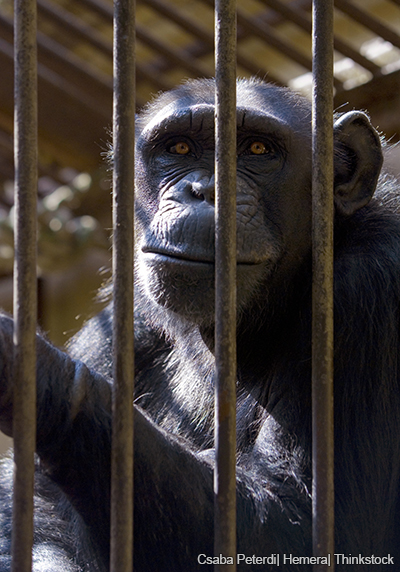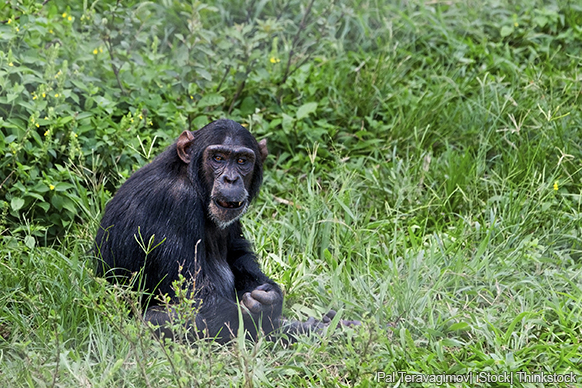Chimps and Us
1 Humans have had a long and complicated history with chimpanzees. Mostly, we have viewed chimps as inferior animals, without feelings and without much intelligence. However, with increasing knowledge of chimpanzees and their capabilities, our ideas have undergone a radical change. In fact, since the mid-1960s, when primatologist Jane Goodall's work with chimps shocked the world, attitudes toward chimpanzees have been transformed.
First Contact
2 Chimpanzees are native to Africa. No one knows when chimps and humans first came into contact, but it seems certain that Africans have long interacted with chimps. Other early human-chimp interactions can be assumed from the long history of zoos, which date from 5,500 years ago or more. Still, no one is sure when a chimp first appeared in a zoo. The first modern zoo, built in Paris in 1793, probably had at least one or two chimps or other great apes.
3 We do know that the use of chimps for science, in entertainment, and as pets, goes back hundreds of years. In 1697 or 1698, one unlucky chimp was captured in Angola in Africa and shipped in a crate to London, England. Dead on arrival, the chimp still proved useful: its dissection led to some of the earliest understandings of human and primate similarities. We also know that some Europeans kept chimps as pets in the early 1700s.
Chimps Go to Work
4 As more contact occurred between the West and Africa during the 1800s and 1900s, interactions between Westerners and chimps greatly expanded. During these years, people in Western countries put chimps to work as entertainers in circuses, zoos, and movies.

5 Chimps in zoos entertained thousands of visitors. Many chimps were dressed up in costumes and placed at a table where they were served tea. This practice began at the London Zoo in 1926 and didn't stop until protests by animal rights activists brought an end to it in 1972.
6 Chimps, of course, weren't just for entertainment. In the 1950s, the United States Air Force obtained large numbers of chimps. These chimps were used in many different experiments: to investigate the effect of weightlessness in flight, to study the efficacy of seat belts, and to follow the course of certain diseases. Many people believe that we have overused these animals for unnecessary, and often cruel, medical research studies. For example, in the 1960s, chimps were used as organ donors for chimp-to-chimp transplants.

Jane Goodall
7 As this maltreatment of chimps was going on, Jane Goodall began the study that would forever change how humans viewed chimpanzees. In 1960, Goodall set out to live among chimpanzees in the Gombe Forest of Tanzania in East Africa. Her detailed studies in the wild documented chimps making tools and using tools, behaviors previously thought to be exclusive to humans.
8 Her studies also showed that chimps lived in complex social groups; like humans, they felt emotions such as pain and sorrow. She also documented aggressive, war-like behavior. When National Geographic broadcast a TV special on Goodall's work in 1965, the public was amazed to learn what these supposedly “simple” creatures could do. Goodall turned conventional thinking about chimps on its head.
9 Spurred on by Goodall's findings, other researchers began studying chimpanzee behavior more closely. New research showed chimps to be problem solvers as well as highly intelligent animals. In one famous study, researchers devoted fifty-one months to teaching sign language to a chimp called Washoe. Washoe not only learned some 150 signs, but she also spontaneously taught them to other chimps. Later studies showed that chimps have number memory (they can recall the numbers one through nine) and, like humans, enjoy doing puzzles for the fun of it.
Rescue and Release
10 As people achieved a better understanding of chimps, groups formed to defend these animals and save them from the cruel practices that many endured. Zoos had long been one of the most serious offenders. At some zoos, chimps suffered in tiny concrete enclosures and were fed only once or twice a day, eating far less than what they would in their natural habitat. Once the babies grew up and became less cute and more aggressive, many of these chimps were killed or abandoned. This abuse was not enacted by zoos alone, but by the military, the motion picture industry, and individual owners. Some chimps were placed in cages and left to die. Even chimps that went into space were met with neglect or abuse when they became too old to be useful to humans.
11 Organizations have worked hard both to stop these abuses and change prevailing attitudes toward chimps. Project R&R, for example, works for the end of the use of chimps in medical research, the release of chimpanzees from laboratories, and the placement of released chimps in sanctuaries. It notes on its website (http://www.releasechimps.org/) how much laboratory chimps suffer when subjected to the ongoing fear, boredom, and stress of experiments. It asserts that chimpanzees are sensitive and suffer breakdowns; moreover, some of them never recover from the trauma they endure.
12 Other organizations have sprung up to offer abandoned chimpanzees a sanctuary. One such organization is Save the Chimps, which provides chimps that have been rescued from labs, the pet industry, and the entertainment industry, with a safe home. On large, three-acre islands complete with hills, palm trees, and grass, family groups of chimps live out the remainder of their life. The chimps are happy and safe.

The Legal Argument
13 Recently, work on behalf of chimpanzees has moved into the courts. Attorney Stephen M. Wise and the Nonhuman Rights Project wanted to end the mistreatment of chimps by asking the court to award chimps some of the same rights as humans. Wise went to court in New York State in December 2013 on behalf of Tommy, a 26-year-old chimp who had been living in a tiny, smelly cage.
14 Wise argued that chimps have the same right as humans not to be imprisoned against their will. According to Wise, chimpanzees should be granted the same rights as a “legal person” because chimpanzees have complex cognitive abilities like humans. Wise's case and others like it have been rejected by New York courts. The Nonhuman Rights Project has, however, promised to file more lawsuits seeking the freedom of other captive animals.
Questions for the Future
15 While some people support Wise's position, others wonder what will happen if we award these rights to chimpanzees. Will we eventually have to do the same for other animals? Will these future court cases lead to more radical changes in how we see chimpanzees and ourselves? Only time will tell.